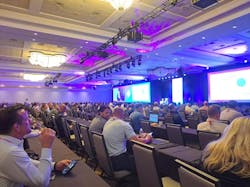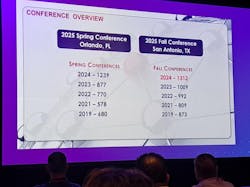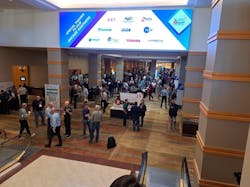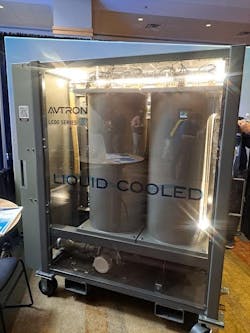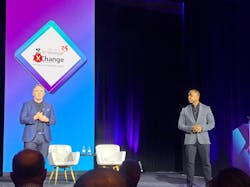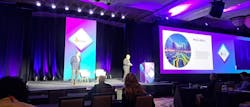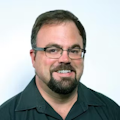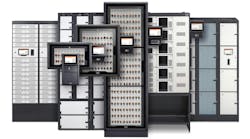7x24 Fall Show Scopes Emerging Trends In Hyperscale, Colo Data Center Sustainability, Construction, AI
Celebrating the professional association's 35th anniversary, the 7x24 Exchange 2024 Fall Conference (Oct. 20-23) descended upon the beautiful desert landscape in Arizona. The Grand Canyon State is home of the towering, long-lived, water-harvesting Saguaro cactus - a sustainable green colossus which seems fairly emblematic of the data center industry.
At the JW Marriott Desert Ridge resort in Phoenix, the nation's 5th largest city and one of its very largest data center hubs, 7x24 Fall Conference participants gathered for three days of conference programming themed upon the topic of emerging technologies for mission-critical data centers. That focus in fact defines a good portion of our scope here at Data Center Frontier, who is a media partner with 7x24 Exchange International.
Since 1989, the conference program has been perennially designed for those involved with 7×24 infrastructures, whether they be IT, data center, disaster recovery, cybersecurity and/or network/telecommunication managers, computer technologists, facility or building managers, supervisors and/or engineers and students from the ranks of electrical, mechanical, architectural, computer science and other disciplines.
Vendors, consultants, and others concerned with uninterrupted access to critical information also comprised the attendees of this year's consecutive sold-out and record-breaking 7x24 Fall Conference, which saw over 1300 participants.
In his opening remarks, 7x24 Chairman and CEO Bob Cassiliano teed up the event's proceedings not without first noting the value of attendee evaluations in selecting conference sites. "We do follow up on them. That's why we pick these locations. You've told us you want to be in resorts in the U.S. South, and as I said at the last conference, Get a pen and draw a line from Florida to San Diego: Anything above that line is out -- we're staying down South."
7x24 Fall Exhibits Thumbnail
The briskly paced exhibit floor at this year's 7x24 Exchange Fall Conference in Phoenix included many demonstrations and discussions on emerging data center technologies including air and liquid cooling, battery backup and energy storage systems, advanced power distribution equipment, and onsite powering platforms for hydrogen-friendly natural gas.
As one example of the technologies on display, Avtron Power Solutions' liquid cooled load banks are designed to meet the demands of modern power testing applications. Engineered for efficiency, precision, and durability, the company's load banks leverage advanced liquid cooling technology to provide superior load testing. Geared for use in data centers, renewable energy systems, or industrial power infrastructure, the Avtron LC00 Liquid Cooled Load Bank series operates up to 500kW at 400/480V amd 50/60Hz to ensure reliable, accurate performance in critical load testing environments. Featuring a steel enclosure with stainless steel piping and tanks to ensure durability and a long life, the system can be fully drained to avoid cross contamination between jobs, and is fitted with industrial grade castors for easy movability.
7x24 Fall Conference: Presentation and Panel Highlights
Keynote: Peter Leyden
7x24 Fall Conference opening keynote speaker Peter Leyden has spent his career figuring out future technology industry trends and helping others better understand what's coming next. He's done this in an unusually wide range of roles in different fields over the years that make him exceptionally good at telling the "big picture" story of our times, and where America and the world are headed in the coming decades, as he did at 7x24. Leyden started his career as a journalist in different regions of America, worked as a foreign correspondent in Asia for Newsweek magazine, and has traveled to more than 50 countries. He now advises senior leaders of top companies on the strategic technology choices that lie just ahead. Leyden came to Silicon Valley at the beginning of the digital revolution to work with the founders of Wired Magazine, and has built an extraordinary network of technologists and entrepreneurs over time. He ran Wired as Managing Editor in its heyday of the 1990s and subsequently founded and ran two of his own media startups focusing on new technologies and the future. He has worked closely with pioneers of the futures business, most recently at The Long Now Foundation, and has mastered the art of strategic foresight and how to track industry megatrends.
Leyden's keynote talk was based on his recent article, The Great Progression - 2025-2050, focusing on the technological advancements expected over the next 25 years, and especially emphasizing the significance of generative AI as a transformative force that has emerged in just the last two years. The article's thesis unpacks the simultaneous emergence of major technologies that could lead to significant societal transformation. The keynote especially highlighted current significant investments in clean energy technologies, particularly solar, and expressed optimism about achieving 100% clean energy by 2035 due to both public and private sector initiatives. Leyden held forth on the transformative impact of AI, explaining the necessary infrastructure developments over the past 40 years that have made AI advancements possible. As one example, he cited the dramatic decrease in the cost of genome sequencing from $3 billion in 2003 to an expected $50 by the end of the decade. Leyden's talk concluded with a discussion on the global landscape of AI, identifying the US and China as the two leading superpowers in this field. Overall, his thesis cited the transformative potential at the intersection of AI and clean energy, while emphasizing that we are at the beginning of a significant era of progress.
"I think folks are going to see the arrival of generative AI, which frankly has only been out for two years now, as a world historical moment," said Leyden.
Siemens, NVIDIA Experts Describe How AI, Digital Twins Will Transform Sustainable Data Centers
The 7x24 Fall Conference's Day One focus tightened to emerging data center design and development with the morning's next presentation entitled, "From Chip Design to Operations: Driving Sustainable Data Center Transformation with AI and Digital Twins," presented by Ciaran Flanagan (L) Global Head of Data Center Solutions, Siemens, and Dion Harris (R), Director of Accelerated Data Center GTM for NVIDIA.
The presentation essentially tackled two dimensions of what AI means for the disruption of the data center industry. In the first piece, NVIDIA's Harris talked about the relentless push toward AI development and implications for the data center industry. For his part, Flanagan imparted specifics on how AI is impacting data center design, build, and operations, and the potential future role for AI in how the industry is run and made sustainable.
Harris likened AI technology's current growth to the first industrial revolution, emphasizing its broad impact across various industries. His remarks focused on the demand side of AI's impact on data centers, noting the explosive growth in AI models and their implications for power consumption and energy sourcing. Harris also discussed the importance of decarbonizing the grid and the engagement with utilities to leverage technology for automating and improving grid efficiency.
Next, Flanagan outlined the challenges faced in modern data centers, including increased power swings and heat density, and emphasized the need for advanced modeling and technologies to manage these complexities effectively. His remarks highlighted the proven technology of digital twins and the significant compute power now available to tackle related problems efficiently. Flanagan also addressed the future roadmap for data centers, highlighting the significance of higher energy densities, diverse power sources, and heat reuse as key innovation opportunities.
Harris provided several examples emphasizing the importance of digitalization with AI and digital twins in achieving sustainable solutions for data centers, stating that innovation is crucial to meet net zero goals. He also noted his company's ongoing work with data center designers to create reference specifications for the transition from NVIDIA's Hopper to Blackwell chips, ensuring readiness for densification and liquid cooling.
Flanagan closed with notes on the availability of digital twin software, including compatibility with various file formats and capabilities for end clients. He challenged technology suppliers to ensure easy integration of digital twins into their technology platforms with standard formats like Autodesk, AutoCAD, and Revit for managing future data centers.
On Oct. 30, Siemens announced a strengthening of its position in industrial software and AI infrastructure with its acquisition of Altair Engineering, Inc., a global leader in computational science and artificial intelligence software. Siemens said its acquisition of Altair allows the company to now offer one of the world's most complete AI-powered design and simulation portfolios.
Focus on 5G and Narrowband IoT (NB-IoT) Possibilities for Data Center Infrastructure, Customers
Hearkening back to 7x24 Exchange's telecom roots, executives from Radix IoT took the Fall Conference stage to discuss "The Impact of 5G and Narrowband IoT (NB-IoT) Technology for Data Center Infrastructure and Customers."
With regard to the topic of telemetry data and its relevance to data centers, the presentation as delivered by Luke Daiske, Co-Founder and COO and Michael Skurla, Co-Founder and Digitization Consultant for Radix IoT, focused on the advantages of NB-IoT communications for data centers, highlighting key technology benefits including excellent coverage, low power consumption, and the potential to enhance decision-making during utility outages through localized data sharing.
The talk emphasized the technical benefits of NB-IoT for mission-critical applications over unlicensed systems. Daiske and Skurla shared a case study illustrating the drastic reduction in carrier costs for IoT devices, demonstrating the financial benefits of transitioning to NB-IoT. The Radix IoT experts also discussed the concept of social IoT, emphasizing its potential to democratize data and improve systems like HVAC and security through shared sensor data.
The Radix IoT experts also explained how internationalization issues have hindered the competitive LoRaWAN technology's expansion into markets like Europe and Japan, while emphasizing how NB-IoT offers benefits such as requiring no cellular infrastructure.
Additionally, the talk addressed concerns regarding security policies banning wireless communication in hyperscaler data centers, arguing that NB-IoT can be more secure than traditional wired systems, offering enhanced security via bespoke encryption and authentication capabilities.
WiMCO Panel: Embracing Innovation in Modular Construction, Sustainability and Operations Efficiency
The theme of 7x24 Fall's annual WiMCO Panel, "Unveiling the Future: Embracing Innovation in Modular Construction, Sustainability and Operations Efficiency," reflected the present data center construction industry's great intersecting interests in the areas of modularity and sustainability, especially in the age of AI-scale demand.
WiMCO stands for Women in Mission Critical Operations and is a program developed by 7x24 Exchange to increase the participation of women in the mission-critical and data center industries. WiMCO's initiatives include: recruiting women into the 7x24 Exchange organization; supporting STEM initiatives, scholarships, and programs; promoting industry opportunities for women; and providing professional leadership opportunities through community.
Session moderator Juli Ierulli (L) serves on the board of directors for 7×24 Exchange International as Vice President, and established and leads the WiMCO community on a national level, as well as 7x24's International Data Center Day initiative. This year's other WiMCO panelists included (L to R) Casey Eldringhoff, Data Center Engineering Operations Cluster Manager for Amazon; Amy Marks SVP, Innovation for Compass Datacenters; and Katie McGinty, VP Sustainability for Johnson Controls.
The panel highlighted the necessity of involving operations team members in design and goal-setting to enhance efficiency, as well as the critical role of AI in reducing energy consumption and improving reliability in buildings.
The discussion also focused on the misconceptions surrounding modular construction, the importance of collaboration among stakeholders, and the need for diversity and reverse mentorship to address the aging workforce in construction. Additionally, emphasis was placed on organizations' genuine commitment to sustainability as a core business operation, linking it to cost savings and talent attraction.
The panel emphasized the importance of involving data center operations team members in a project's design and goal-setting processes to improve outcomes and efficiency. The presentation also stressed the need for understanding the various forms of the modular data center construction approach and their impact on sustainability.
The talk further outlined the critical role of AI in reducing energy consumption in buildings and improving operational reliability through digitalization. The speakers also emphasized the necessity of collaboration between electrical contractors and operators, advocating for early involvement of all stakeholders to facilitate innovation and effective project execution.
Concerns about the construction industry's aging workforce were also raised, with the panel noting the lack of diversity and the need for reverse mentorship to bridge generational gaps in expected work experiences.
The panel also addressed the evolving perception of sustainability from being a peripheral item, to becoming critical for business operations, while linking sustainability concerns to cost savings and attracting talent from younger generations.
The importance of understanding the true motivations behind sustainability efforts was also highlighted, emphasizing a need for genuine commitment rather than simply following trends.
Also discussed were ways to strategize and implement plans to move work off-site by collaborating with manufacturers, subcontractors, and general contractors to enhance product development, pre-kitting, ESG programs, and data-driven performance evaluations to achieve specific milestones and success criteria.
A case-study plan was presented for a power-positive data center initiative that includes using 78% less energy, behind-the-meter renewables, and employing community infrastructure improvements to present to regulators for approval.
The talk also cited the importance of efforts made in transitioning from rhetoric to operations by harnessing the power of climate and sustainability issues to drive strategic outcomes, making the topic a competitive differentiator within companies.
About the Author
Matt Vincent
A B2B technology journalist and editor with more than two decades of experience, Matt Vincent is Editor in Chief of Data Center Frontier.


